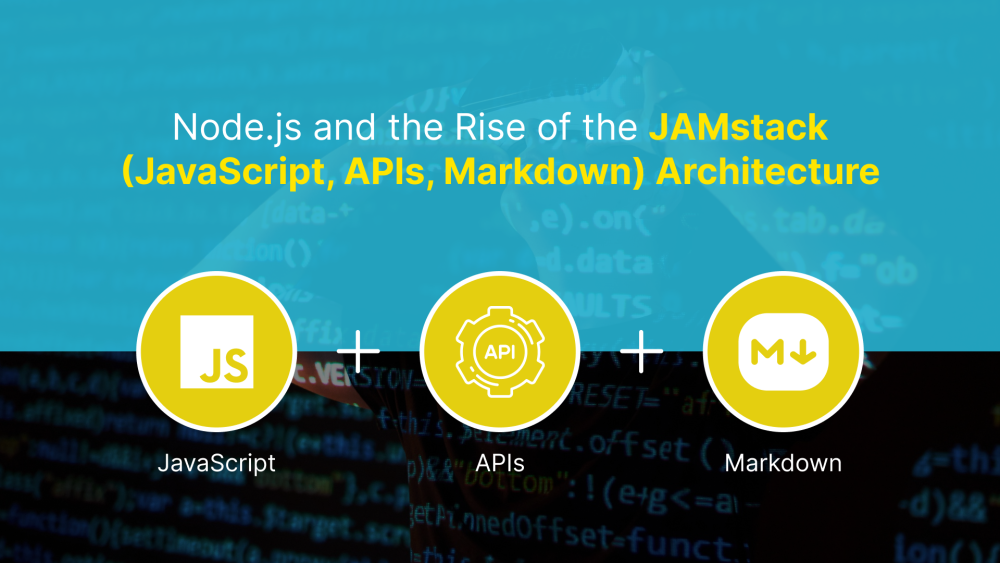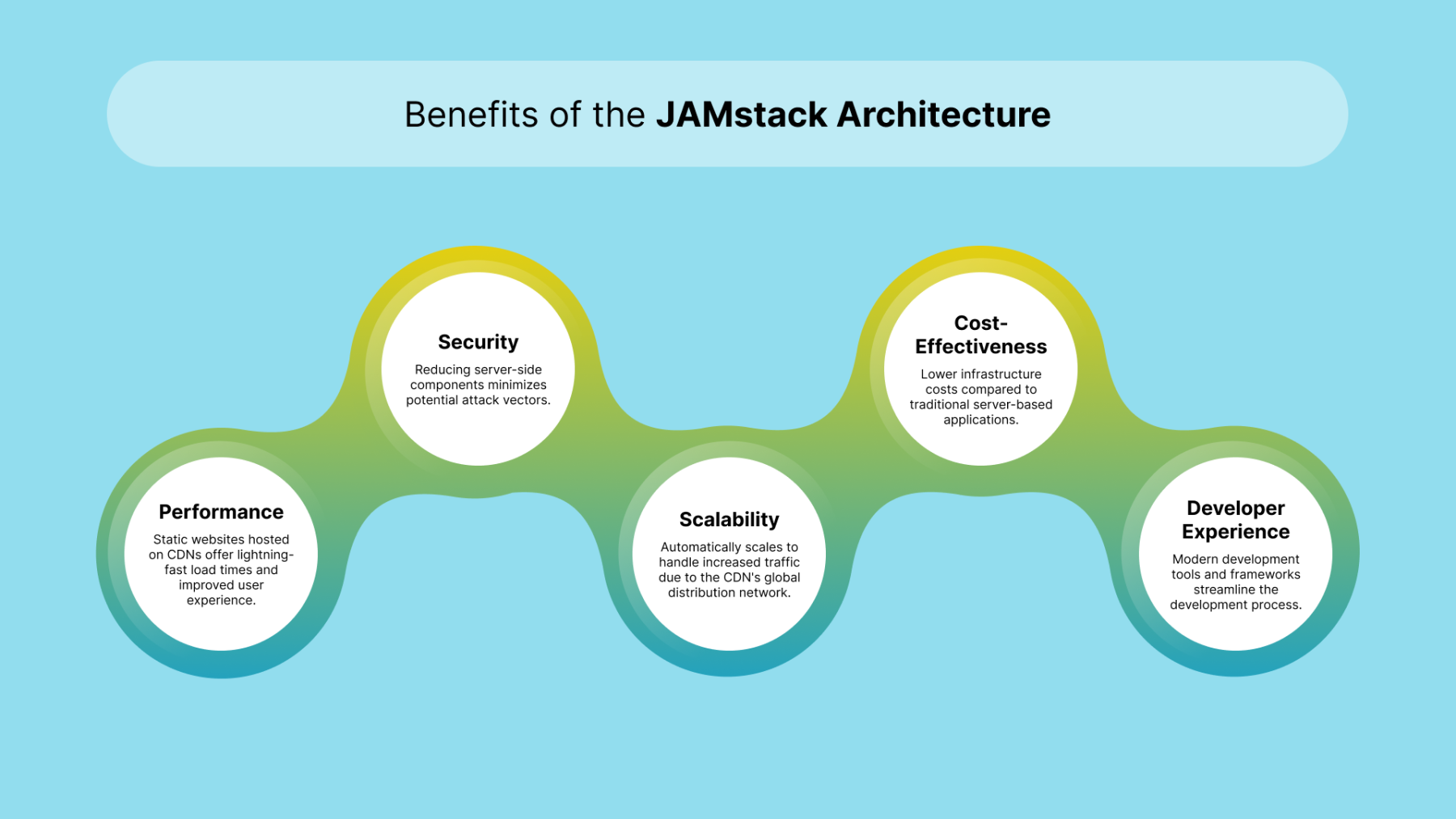The digital landscape has witnessed a paradigm shift in web development, marked by the emergence of the JAMstack architecture. This modern approach leverages JavaScript, APIs, and Markdown (JAM) to create static websites with dynamic capabilities. Node.js, a powerful JavaScript runtime, plays a pivotal role in this ecosystem.
This blog delves into the intricacies of the JAMstack architecture, exploring its benefits, use cases, and the role of Node.js in its implementation. We will examine the technical aspects of building JAMstack applications, discuss the advantages it offers over traditional web development, and explore the integration of various tools and technologies within the JAMstack ecosystem.
Understanding the JAMstack Architecture
The JAMstack is a modern architecture for building fast, secure, and scalable web applications. It differs from traditional web development by decoupling the frontend from the backend, resulting in pre-rendered static websites served directly from a content delivery network (CDN).
Key Components of the JAMstack:
-
JavaScript: Handles client-side interactions, dynamic features, and user experience.
-
APIs: Provide data and services to the frontend, enabling dynamic content and interactions.
-
Markdown: Used for creating content, providing a simple and human-readable format.
This architecture offers several advantages, including improved performance, enhanced security, and simplified deployment.
The Role of Node.js in the JAMstack
Node.js serves as the backbone of the JAMstack, powering serverless functions, API development, and build processes. Its non-blocking, event-driven nature makes it ideal for handling asynchronous operations efficiently.
Key Node.js Use Cases in JAMstack:
-
API Development: Building RESTful or GraphQL APIs to provide data to the frontend.
-
Serverless Functions: Creating serverless functions for handling dynamic logic, integrations, and custom backend processes.
-
Build Tools: Utilizing Node.js-based tools like Gatsby, Next.js, and Hugo for building static sites and generating optimized assets.
By leveraging Node.js, developers can create robust and scalable JAMstack applications that deliver exceptional user experiences.
Benefits of the JAMstack Architecture
-
Performance: Static websites hosted on CDNs offer lightning-fast load times and improved user experience.
-
Security: Reducing server-side components minimizes potential attack vectors.
-
Scalability: Automatically scales to handle increased traffic due to the CDN's global distribution network.
-
Cost-Effectiveness: Lower infrastructure costs compared to traditional server-based applications.
-
Developer Experience: Modern development tools and frameworks streamline the development process.
A recent study by Netlify https://www.netlify.com/ found that JAMstack websites load significantly faster than traditional websites, leading to improved user engagement and conversion rates.
Building JAMstack Applications
To build a JAMstack application, follow these general steps:
-
Create Content: Write content in Markdown format, leveraging tools like Git for version control.
-
Develop Frontend: Build the frontend using JavaScript frameworks like React, Vue, or Angular.
-
Create APIs: Develop RESTful or GraphQL APIs using Node.js and frameworks like Express or Apollo Server.
-
Build and Deploy: Use a JAMstack-focused build tool (Gatsby, Next.js, Hugo) to generate static assets and deploy them to a CDN.
Integrating JAMstack with Other Technologies
The JAMstack's modular architecture enables seamless integration with various tools and services:
-
Headless CMS: Integrate with headless CMS platforms (e.g., Strapi, Contentful) to manage content efficiently.
-
Payment Gateways: Integrate with payment gateways (e.g., Stripe, PayPal) for e-commerce functionalities.
-
Email Services: Integrate with email services (e.g., SendGrid, Mailgun) for transactional and marketing emails.
-
Analytics Tools: Integrate with analytics platforms (e.g., Google Analytics, Segment) to track user behavior and performance metrics.
By combining the JAMstack with these technologies, you can create powerful and feature-rich web applications.
Challenges and Considerations
While the JAMstack offers numerous advantages, it's essential to consider potential challenges:
-
Client-Side Rendering Limitations: Some complex interactions might require server-side rendering or hybrid approaches.
-
SEO Challenges: Proper SEO implementation is crucial for search engine visibility, requiring careful optimization.
-
Developer Expertise: Building JAMstack applications requires proficiency in JavaScript, APIs, and frontend development.
Overcoming these challenges requires careful planning and the use of appropriate tools and techniques.
The Future of JAMstack
The JAMstack is rapidly evolving, with new tools and technologies emerging to enhance its capabilities:
-
Serverless Functions: The growing popularity of serverless functions is expanding the possibilities for backend logic and integration.
-
Static Site Generation (SSG): Advancements in SSG tools are improving performance and SEO for JAMstack applications.
-
Edge Computing: Leveraging edge computing for real-time processing and content delivery is becoming increasingly prevalent.
-
Emerging Frameworks: New frameworks and libraries are continuously being developed to simplify JAMstack development.
By staying updated with these trends, developers can harness the full potential of the JAMstack architecture and build cutting-edge web applications.
Conclusion
The JAMstack architecture, powered by Node.js, represents a significant shift in web development, offering numerous benefits in terms of performance, security, and scalability. By understanding its core principles, leveraging the right tools, and addressing potential challenges, developers can build exceptional web experiences. As the JAMstack ecosystem continues to evolve, it's crucial to stay informed about the latest advancements to remain at the forefront of web development.



